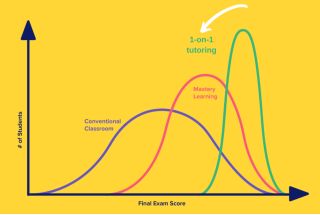Education
How A.I. Chatbots Could Solve The Two Sigma Problem
Generative A.I. tutors may revolutionize teaching and learning.
Updated July 15, 2023 Reviewed by Kaja Perina
Key points
- One-on-one tutoring helps students go from a C to an A.
- It's not the academic content alone. The relationship between student and tutor produces academic success.
- Generative A.I. chatbots are about to revolutionize learning.
- A.I. chatbots can tailor lessons for each student and free up teacher time.
In his 1984 paper, The Two Sigma Problem, educational psychologist Benjamin Bloom demonstrated that building “more favorable conditions” into all of the environments in which children grow and learn will put many children on the path to realizing their fullest potential. His proxy for favorable conditions: an individual tutor.

Bloom found that with one-on-one tutoring, a student performing at the 50th percentile could improve by 2 standard deviations. That’s the rough equivalent of going from a C in Algebra to an A.
But here’s the thing, when he studied his data, Bloom realized that the active ingredient that generated such impressive outcomes was not academic content alone. It was the content and the connection. The nature of the student’s relationship with the tutor was key. Constant feedback, belief, reinforcement, and encouragement produce progress.
The Karate Kid
.png.jpg?itok=Kv8Ibn0C)
If you want to picture that kind of connection, think of the movie The Karate Kid, which, like Bloom’s paper, was released in 1984. The author and teacher-educator Zaretta Hammond says every teacher needs to be a Mr. Miyagi and every student a Daniel. That’s because Mr. Miyagi supported Daniel and believed in him but he also pushed him to work harder, build new skills, strength, stamina, and take risks during performance.
A Problem of Scale
For nearly 40 years now, few have questioned the power of tutoring, mentoring, and coaching to change the game for many young people. The problem was we never found a way to scale it. Tutoring is expensive and time-consuming! And finding a happy match between student and tutor isn’t easy.
We did, however, find ways to scale access to academic materials, to scale instruction. Think of online learning, most notably Khan Academy, which since 2006 has offered high-quality, videotaped lessons for free anytime, anywhere. Widespread academic gains, however, have yet to follow.
The Promise of A.I. Chatbot Tutors
Today, though, we may be on the verge of scaling the secret sauce in Benjamin Bloom’s findings: the student-tutor relationship. Generative Artificial Intelligence offers the possibility of providing every student everywhere with a simulated online tutor in the form of a chatbot. These experimental chatbots - Khan Academy’s Khanmigo and Duolingo’s Duolingo Max among them - are already learning how each student learns. They respond to student questions in a conversational tone, assessing students’ strengths and weaknesses. They then generate individualized lesson plans to support and push students to the next level. Instead of giving up when something is hard and quitting, students are encouraged to keep trying. Productive struggle turns into progress.
Unlike human tutors, chatbot tutors are available around the clock. They can also respond to large numbers of students at the same time. In a matter of seconds, they summon primary texts, quizzes, works of art, and instructional videos. They can even embody historical or literary characters - think Frederick Douglass, Holden Caufield, or Marie Curie - or create virtual learning environments - imagine a NASA flight deck, Egyptian tomb, or Amazonian rain forest - to enhance the learning experience.
More Time for Teachers and Relationships
Lesson planning takes up a big chunk of precious teacher time. Generative A.I. could change that too, and not only that–personalize it which is hard to do in a classroom of 30 young people. Chatbots are able to create individualized lesson plans for each child in a classroom. If deployed this way, A.I. will free up teachers to spend more time connecting with their students. And if that happens, the most important relationships of all, the human ones, will have more time to flourish. The Two Sigma Problem will finally have a solution.
References
Bloom, B. S. (1984). The 2 Sigma Problem: The Search for Methods of Group Instruction as Effective as One-to-One Tutoring. Educational Researcher, 13(6), 4–16. https://doi.org/10.2307/1175554


